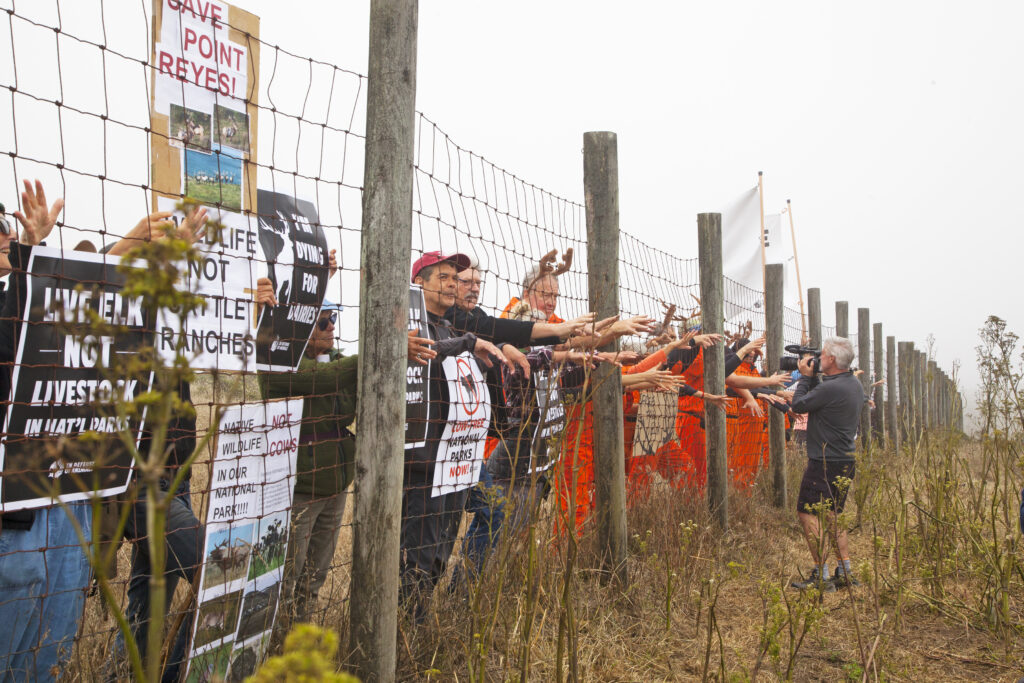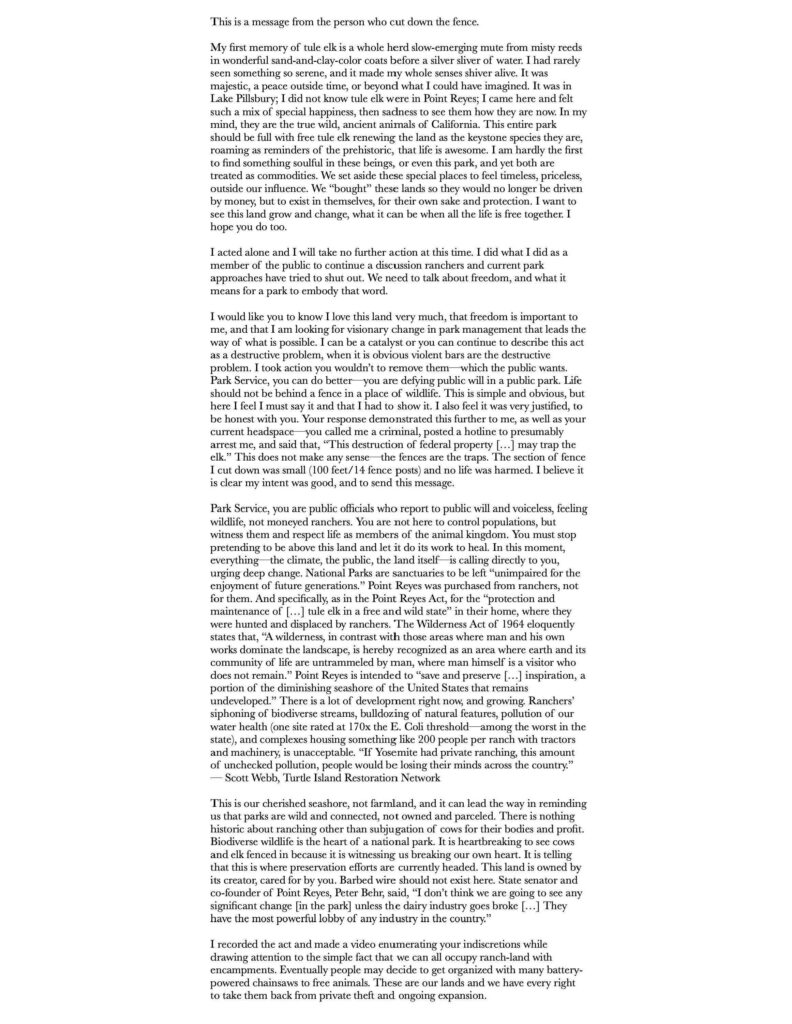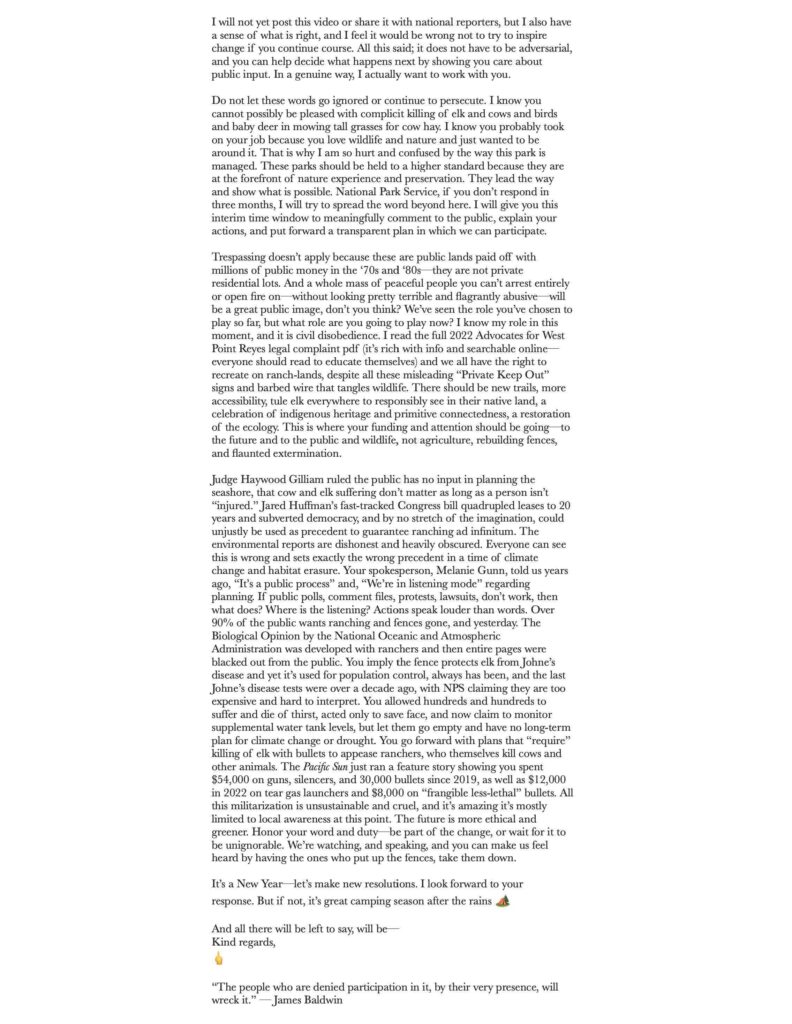An anonymous vandal is drawing attention to the historic plight of hundreds of Tule elk trapped behind a wire and post fence at the northern tip of the Point Reyes National Seashore. During drought seasons, fenced-in elk often die by the hundreds, unable to access ponds, streams and forage set aside for 5,000 privately owned cattle on the other side of the eight-foot fence.
In mid-October, someone chain sawed down 14 fence posts, leaving 100 feet of drooping wire fence intertwined with a handwritten banner reading, “LIFE IS FREE.”
The National Park Service (NPS), which owns and manages Point Reyes, announced a criminal investigation into the act and set up a tips hotline—415-464-5177. The TreeSpirit Project, an animal rights group calling for the removal of the dairy and beef cattle operations which lease a third of the Seashore, delayed a planned protest out of concern that non-violent environmentalists would be associated with the criminal act.
However, news of the destruction didn’t spread beyond a few Marin County news outlets, and interest in “Who done it?” dwindled. Apparently, that disappointed the fence killer.
On Jan. 2, an anonymous Twitter user, @iliketuleelk, posted a two-page letter taking credit for the fence cutting. Two photos accompany the manifesto. The first shows the felled fence and banner, and the second a hand pushing a chainsaw through a fence post. The Tweet tagged the NPS and the Department of the Interior’s Twitter accounts, garnering only a few views.
A week later, iliketuleelk emailed this publication a link to the Tweet alongside a confession, “I cut down part of the fence in October and now wrote this note to NPS—might be a little direct, but trying to put pressure on officials.”
“The entire park should be full with free tule elk renewing the land as the keystone species they are, roaming as reminders of the prehistoric, that life is awesome…,” the manifesto states in part. “I acted alone and I will take no further action at this time. I did what I did as a member of the public to continue a discussion ranchers and current park approaches have tried to shut out. We need to talk about freedom, and what it means for a park to embody that word.”
In recent years, a variety of advocacy groups have called attention to the NPS policies of allowing private agricultural operations to grossly pollute the Seashore, and fenced-in Tule elk to die of thirst and starvation.
Activists have been careful not to break the law as part of demonstrations, some of which use the fence as a dramatic prop depicting elk as orange-suited prisoners.

Following the discovery of the crime scene, NPS spokesperson Melanie Gunn said that the downed fence posed a potential danger to the Tule elk and other mammals, which could become ensnared trying to cross the tangled wires. Gunn said that the fence repairs were completed on Oct. 20 and cost $3,461.
The manifesto pushes back on the safety criticism, arguing that the existence of the fences is the real injustice. “Life should not be behind a fence in a place of wildlife… [After I cut the fence, Gunn] said that, ‘This destruction of federal property […] may trap the elk.’ This does not make sense—the fences are the traps. The section of fence I cut down was small… and no life was harmed. I believe it is clear my intent was good…”
In interviews last week, a handful of environmental activists and a Point Reyes rancher also raised safety concerns. While the activists support removing ranches and dairies from the park, along with fences restricting the movement of Tule elk, they also voiced various degrees of skepticism about whether cutting a short piece of fence was an effective tactic.
Laura Cunningham, California director of the Western Watersheds Project, one of three national environmental groups waging a federal lawsuit to remove ranching from the park, said their group is working with locals to free the elk, but is committed to doing “everything above board… [and] not [to] participate in any illegal activities.”
“I was against this [fence cutting] and rather shocked, because just chain sawing down the fence there will not do anything for the elk. And, if the elk had gotten out, the Park Service would just try to round them up and put them back in… It was a stunt, and I don’t like the illegal nature of it, and I don’t think it furthers our cause of rescuing the elk from that area,” Cunningham said.
Jack Gescheidt, the founder of the TreeSpirit Project, said that he reported the felled fence to the Park Service on Friday, Oct. 14. TreeSpirit then postponed a planned protest, posting on its website that “We condemn the vandalism which creates a hazard to the elk. And doesn’t change federal policy which imprisons them.”
Now that someone with an anonymous Twitter account is taking credit for the crime, Gescheidt is more sympathetic.
“When I first learned about the fence vandalism, I wondered what good would come of it—elk wandering out onto ranch lands would likely be traumatically rounded up by the NPS. Now that the fence-cutter seeks publicity, I see it a bit differently: doing property damage (and risking arrest) to raise awareness, to save more elk from dying,” he wrote in a statement to this newspaper.
Matt Maguire is a former Petaluma City Council member long involved in calling for restoring the Seashore to its pre-agricultural ecology.
“I’m not surprised that somebody did this. The more the public finds out how the Park Service is derelict in its duties, acting as the handmaiden of the ranchers, the more people are furious,” Maguire said.
He acknowledged that the fence cutting could backfire, politically: “It hands a rhetorical club to the ranchers and the Park Service to say: ‘See, these elk activists are wild extremists who will go to no ends,’ which obviously is not true…”
For example, in an April 2021 email to executives at the San Francisco Bay Regional Water Quality Control Board, a Marin County representative of the Western United Dairies, an industry group, wrote that “dairies in the national seashore have been dealing with rampant, often unmitigated and sometimes violent protesters for months, with yet another demonstration planned this Saturday in the park.” Western United Dairies did not respond to a request for evidence of the claim of violence when this newspaper reached out for comment last fall while reporting “Don’t Look Down!”, an article about agricultural pollution in the Seashore.
Theresa Harlan advocates for the protection of endangered Indigenous archeology and historical structures, and clean water and humane environments for the Tule elk in the park, as well as for the removal of ranches.
She said that the vandalism “feeds into a false belief that environmental activists at Point Reyes support vigilante acts to correct wrongs. I believe that the fences should be brought down, but that action needs to be deliberate and methodical and legal.”
The anonymous manifesto observed, correctly, that more than 90% of public comments solicited by the NPS for a 2020 Environmental Impact Statement called for the non-renewal of scores of expired ranching leases and the restoration of the grazed, polluted lands.
Kevin Lunny, who operates a ranch approximately three miles overland from the felled fence, supports keeping agricultural operations within the park.
“It was very dangerous-looking. We have livestock, and we know what it’s like if a fence is half down. Now, if they had cut the wires and opened it up, that would have allowed safe passage. But, to just let the fence lay down, that’s pretty dangerous,” Lunny said.
Reached by email last week, the anonymous fence killer declined to disclose their identity.
“I will withhold my identity at this time! My aim is to continue discussion, not get arrested, which it seems is the direction they are headed,” iliketuleelk wrote.
The full Jan. 2 letter is available below.













